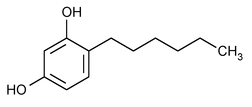Hexylresorcinol
(hex'' il re sor' si nol).
» Hexylresorcinol, dried over silica gel for 4 hours, contains not less than 98.0 percent and not more than 100.5 percent of C12H18O2.
[Caution—Hexylresorcinol is irritating to the oral mucosa and respiratory tract and to the skin, and its solution in alcohol has vesicant properties.
]
Packaging and storage—
Preserve in tight, light-resistant containers.
Identification—
A:
To 1 mL of a saturated solution of it add 1 mL of nitric acid: a light red color appears.
B:
To 1 mL of a saturated solution of it add 1 mL of bromine TS: a yellow, flocculent precipitate is formed. Add 2 mL of 6 N ammonium hydroxide: the precipitate dissolves, producing a yellow solution.
Melting range, Class I  741
741 :
between 62
:
between 62 and 67
and 67 .
.
Acidity—
Dissolve 250 mg in 500 mL of water, add methyl red TS, and titrate with 0.020 N sodium hydroxide: no more than 1.0 mL is required for neutralization.
Residue on ignition  281
281 :
not more than 0.1%.
:
not more than 0.1%.
Mercury—
[note—Select all reagents for this test to have as low a content of mercury as practicable, and store all reagent solutions in containers of borosilicate glass. Glassware used in this test shall be specially cleaned by being soaked in warm 8 N nitric acid for 30 minutes and rinsed with water. Keep flasks for this determination separate from other flasks, and use only for mercury determinations. ]
Standard preparation—
Transfer 34.0 mg of mercuric chloride to a 250-mL volumetric flask. Add 1 drop of hydrochloric acid, add water to dissolve, and dilute with water to volume. Transfer 1.0 mL of this solution to a 100-mL volumetric flask, add 1 drop of hydrochloric acid, and dilute with water to volume. Transfer 1.0 mL of this solution to a 500-mL volumetric flask, add 1 drop of hydrochloric acid, and dilute with water to volume.
Test preparation—
Transfer 134 mg to a 250-mL beaker, and cautiously add 10 mL of 11 N nitric acid and 10 mL of 18 N sulfuric acid. Digest, with the aid of heat, in a well-ventilated hood until the evolution of brown fumes ceases. Cautiously add an additional 10 mL of 11 N nitric acid, and continue heating until no more fumes are evolved. Cool, transfer to a 200-mL volumetric flask, and dilute with water to volume.
Procedure—
Transfer 100 mL of Standard preparation to a 300-mL mercury analysis reaction vessel, add 2 drops of potassium permanganate solution (1 in 20), and mix (the solution should be purple; add additional permanganate solution dropwise, if necessary). Add 5 mL of 11 N nitric acid, stir, and allow to stand for not less than 15 seconds. Add 5 mL of 18 N sulfuric acid, stir, and allow to stand for not less than 45 seconds. Add 5 mL of hydroxylamine hydrochloride solution (3 in 200), stir, and allow to stand until the solution turns light yellow or colorless. Add 5 mL of stannous chloride solution (1 in 10) [note—Disregard the presence of insoluble matter in this solution; mix prior to use ] , immediately insert the aerator connected to the air pump, and determine the maximum absorbance of the treated Standard preparation at the mercury resonance line of 253.65 nm, with a suitable atomic absorption spectrophotometer equipped with a mercury hallow-cathode lamp and an absorption cell that permits the flameless detection of mercury. Connect in a closed system with a circulating air pump, a calcium chloride drying tube, and an aerator inserted in a 300-mL reaction vessel so that air passed through the treated preparation contained in the reaction vessel evaporates any metallic mercury present. In a similar manner, treat 100 mL of the Test preparation and 100 mL of water (reagent blank), and determine the maximum absorbances at the same wavelength [note—Check the zero setting of the instrument frequently ] . The absorbance of the solution from the Test preparation does not exceed that of the solution from the Standard preparation (3 ppm).
Resorcinol and other phenols—
Shake about 1 g with 50 mL of water for a few minutes, filter, and to the filtrate add 3 drops of ferric chloride TS: no red or blue color is produced.
Assay—
Dissolve 70 mg to 100 mg of Hexylresorcinol, previously dried over silica gel for 4 hours and accurately weighed, in 10 mL of methanol in a 250-mL iodine flask. Add 30.0 mL of 0.1 N bromine VS, then add quickly 5 mL of hydrochloric acid, and insert the stopper in the flask immediately. Cool the flask under running water to room temperature, shake vigorously for 5 minutes, then set aside for 5 minutes. Add 6 mL of potassium iodide TS around the stopper, cautiously loosen the stopper, again insert the stopper tightly, and swirl gently. Add 1 mL of chloroform, and titrate the liberated iodine with 0.1 N sodium thiosulfate VS, adding 3 mL of starch TS as the endpoint is approached. Perform a blank determination (see Residual Titrations under Titrimetry  541
541 ). Each mL of 0.1 N bromine is equivalent to 4.857 mg of C12H18O2.
). Each mL of 0.1 N bromine is equivalent to 4.857 mg of C12H18O2.
Auxiliary Information—
Please check for your question in the FAQs before contacting USP.
| Topic/Question | Contact | Expert Committee |
|---|---|---|
| Monograph | Behnam Davani, Ph.D., M.B.A.
Senior Scientific Liaison 1-301-816-8394 |
(SM12010) Monographs - Small Molecules 1 |
USP35–NF30 Page 3410
